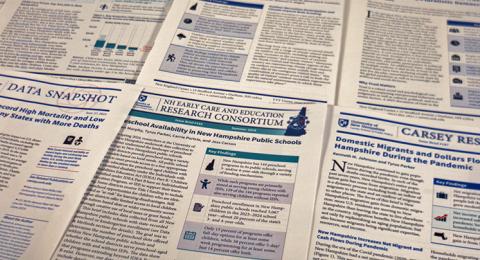Welcome!

This webpage is designed to help you create a successful publication that will empower your research by making it accessible to a wider variety of readers. First, thank you for writing a Carsey publication. At the core of our work is getting top quality, timely research findings and ideas related to our mission into the hands of audiences across the globe.
Writing for Carsey is different than writing for academic journals—which is generally intended to build on past work and for use by other academics. Our audience is broader and includes researchers, policymakers, non-profit organizations, educators, media outlets, and community members.
As you write, think about your primary audience as a smart, busy reporter. Reporters need to find information quickly and the implications of the research must be clear and compelling. The value of writing for Carsey is in exposure to new, public audiences. Our goal is to make sure that everyone who needs to know about your research gets to read it, understand it, use it, and share it.
Please take a few moments to read through this information; it will be useful as you prepare your publication.
A compelling Carsey publication includes the following:
- High-quality information with new, important key findings
- A clearly articulated story with strong, accessible writing
- Explanation and context showing why the research or idea/perspective is relevant
- Timely, media friendly, policy relevant, and thought-provoking information that will be used by a mix of non-academic audiences
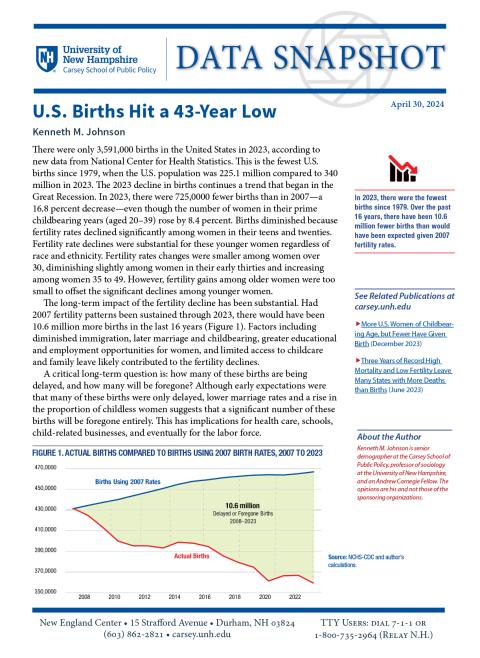
A data snapshot is a single-page document that shares one new idea. It typically includes one key finding, one to two paragraphs of text (approximately 200 words), and one figure or table.
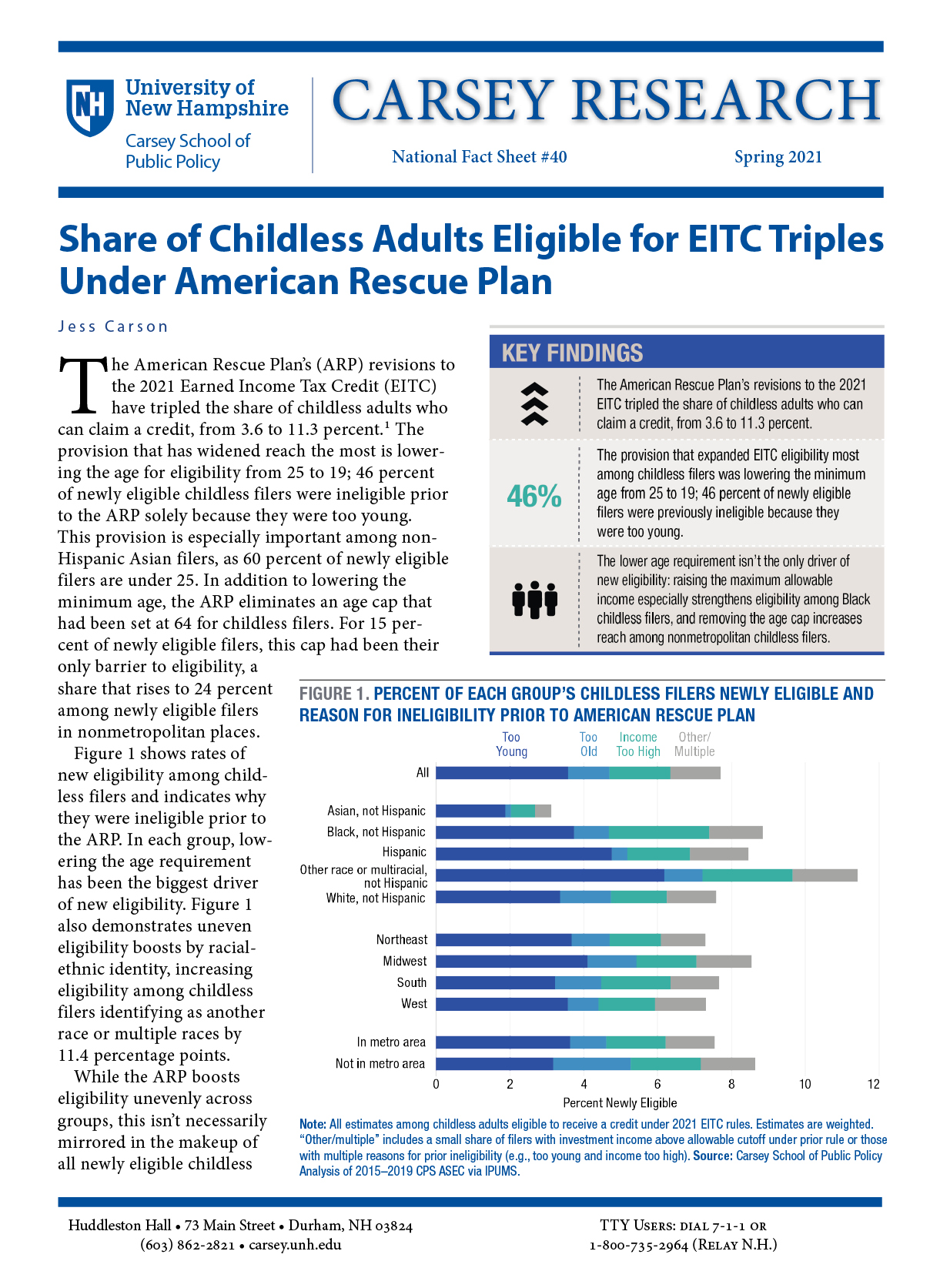
A fact sheet is a two-page document (approximately 900 to 1,000 words) sharing one or two key findings; text supporting the key findings; one to two figures or tables; a conclusion with policy recommendations; acknowledgements; and an About the Author(s) section.
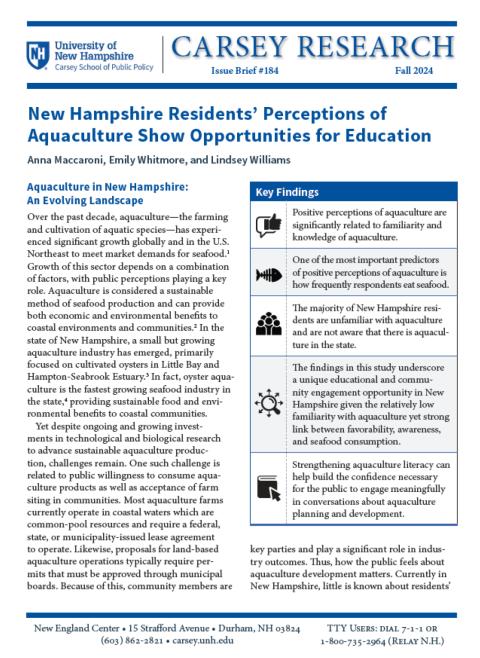
An issue brief is a four- to eight-page document (approximately 1,800/2,000 to 3,600/4,000 words), typically containing several key findings; a summary section; text supporting the key findings; maps, figures, and/or tables; a conclusion with policy recommendations; a data or methods section; acknowledgements; and an About the Author(s) section.
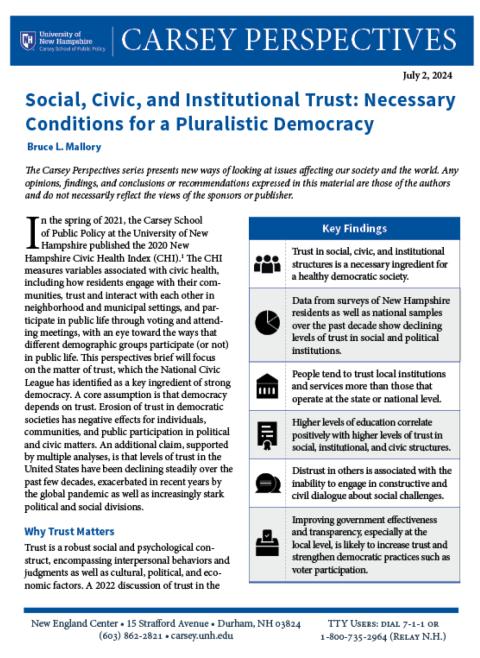
A perspectives brief is a less formal version of an issue brief that shares opinions, findings, and conclusions or recommendations. It may or may not include original analysis, and often synthesizes existing work to offer new ways of looking at issues affecting our society and the world.
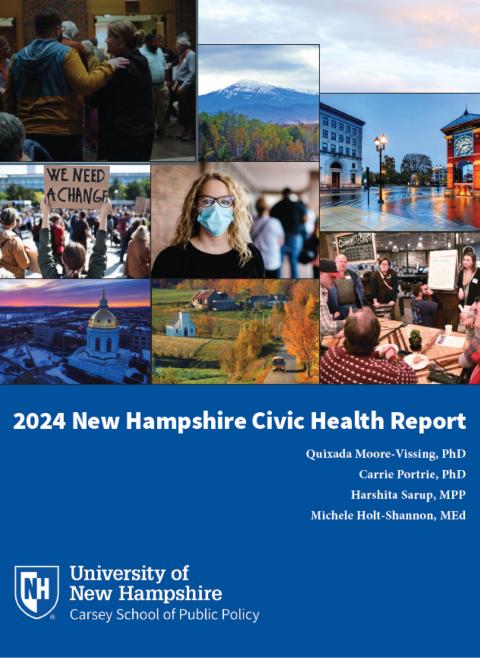
A report is a longer version of an issue brief (generally 20 pages plus).
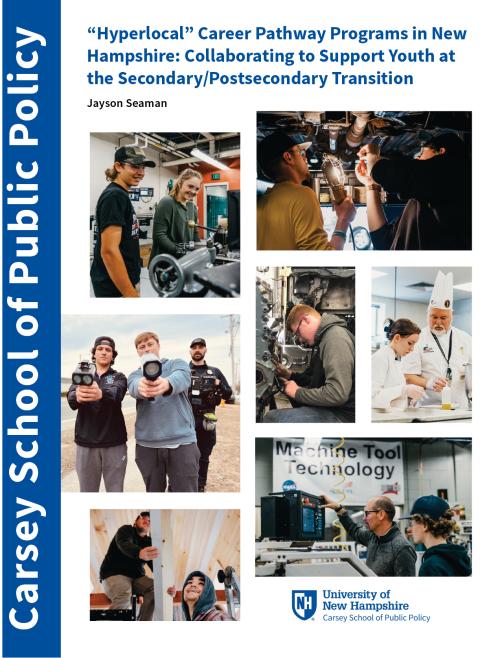
A white paper is an in-depth report or guide about a specific topic and its policy-relevant problems and solutions. White papers are often intended for a niche audience and can be more technical than an issue brief. There is no length requirement.

Every publication is unique, and it goes through production at the rate required to ensure a successful publication for the author. The Carsey process is different than a peer-reviewed process in that each publication is reviewed by the Carsey publication team (“pub team”): a mix of professionals who are likely not experts in the author’s field. We find that authors benefit from comments of professionals with diverse lenses, not just their research peers, when writing for a more general audience. We will work closely with you to help you create a product that will benefit you and the Carsey publication library. The communications coordinator (Laurel Lloyd ) is your point of contact throughout the publications process.
General steps include:
-
Prospective author completes proposal form to Carsey's communications coordinator. This form helps us organize basic information we need for every publication to proceed and lets us review and approve projects before authors get underway.
-
Coordinator shares Carsey pub team feedback with prospective author, generally within one week. If accepted, process ensues.
-
Author submits first draft to coordinator. This includes a Word document and any graphs and tables in separate, editable files (Excel or .eps format).
-
Coordinator shares pub team feedback with author, generally within one week. Proposed edits utilize tracked changes in a Word document.
-
Author submits second draft to coordinator. Note that draft may go to external editor for additional line-editing, policy-lens commentary, or other feedback as needed to create a strong, valuable final publication.
-
Coordinator shares pub team feedback with author, generally within one week.
- Author submits final/third draft to coordinator who will confirm that production is ready to start. Note that, on occasion, additional draft is required.
- Coordinator submits copyedited and formatted pdf proof to author for review.
- Author submits any edits to coordinator.
- Coordinator submits second pdf proof to both author and pub team for final review.
- Once content is approved, communications coordinator prepares online version. Author will receive drafts of email blast announcing the pub, social media blurb, and possible promotional photo options for review. The coordinator confirms the release date.
- On day of release, coordinator posts the publication to Scholars' Repository, makes the brief live on Carsey website, and posts banner on Carsey's homepage announcing release of pub. The digital marketing manager posts social media content to Carsey's social media platforms (Twitter, Facebook, LinkedIn, etc.)
We have compiled some tips for the basic components of your article, which will likely include these elements:
Title
During the later stages of production, we will work with you on a title that pops and reflects the “story” about your article. The title should echo the main finding of the brief and be catchy.
Key Findings
If readers only remember two key points from your publication, what would they be? Start with two or three bullet points stating the key findings of your research. These findings will appear in a separate box. They should be able to stand on their own without an introduction and highlight a key finding from the research that you want the reader to remember. Think of a key finding as a hook to an important point in the brief…along the lines of a Tweet in both length and tone. Minimize the use of numbers in key findings unless absolutely essential.
Summary

This section provides readers with a high-level overview of the publication up front. When writing the summary, think of the inverted pyramid approach used by journalists. The widest part at the top represents the most substantial, interesting, and important information you want to convey (essentially, your conclusion), while the tapering lower portion illustrates the other information you want to convey, in order of diminishing importance. With this approach, readers can leave the story at any point and understand it, even if they do not have all the details. The summary should be one to three paragraphs.
Main Text
-
Flesh out the main story and discuss what the data show.
-
Organize the text according to the key findings to ensure that the most important points are highlighted and to streamline the information for readers. As you write, consider a busy, smart reporter, who may not need to understand the intricacies of your work. Frame the work in the bigger world, and explain why it was important to look at the data you analyzed. What are the possible “real world” ramifications of your findings?
-
The conclusions and implications are significantly more important to this audience than the background and methods, so minimize your review of background material and move any data or methods sections to the end of the publication.
- If something technical is important, be sure you explain it, similar to how a journalist might explain it in The New York Times. If it is important to researchers but not to a general reader, consider including it in an endnote.
- Set off sections with sub-headings in bold type and strive to make the headings substantive rather than just organizational so they’re useful for someone just scanning the brief (for example, “SNAP Use Rose” rather than “Changes in SNAP Use”).
Figures/Maps
-
Please embed the figures within your Word file for ease in reviewing. Eventually, you'll need to send the communications coordinator each figure in a separate sheet in an Excel file for formatting. Figures created in .eps format are also acceptable.
-
Figure titles go in the Word document, rather than in the figure itself, and appear above the figure.
- Include sources for figures. Sources go in the Word document, rather than in the figure itself, and appear below the figure.
- Put any technical detail, such as sample size or statistical significance, in a figure note below the graphic rather than in the figure itself. Notes go in the Word document below the graphic figure rather than in the figure itself.
- Figures can be full color, although thecolors you choose may not be the final colors used. The communications coordinator reviews and adjusts all figures for both house style and ADA compliance.
Tables
- Provide tables in Excel in separate sheets.
- Include sources for table data.
- If you’re unsure about whether your statistical analysis will be too complex, please check with us. Typically, percentages and means are acceptable to present, but regression coefficients are not.
Sidebars
Used occasionally as appropriate, often to define terms, give context, or for case studies/regional stories—discuss this option with the coordinator if relevant.
Conclusion
- Reiterate the key findings from the story in a way that ensures readers walk away with your key insights.
- Policy briefs: These briefs should connect your findings to policy implications—whether that means actually proposing something or describing just how it might inform decisions to be made in policy making or how it might suggest a policy direction. You don’t necessarily need to make a policy recommendation, but please shy away from vague language such as, “policy makers should keep these findings in mind as they look at the issue.”
Data or Methods Section
Provide a “Data” or “Methods” section at the end of the brief. You can put a note about calculations for statistical significance here (as that more technical information should not be in the main body of the text).
Definitions Box
If you are using terms that may be unfamiliar to a general audience, provide a short definition of each term.
About the Author(s)
This section should include a single sentence with your name, affiliation, and title.
Example: Jess Carson is the director of the Center for Social Policy in Practice and a research assistant professor at the University of New Hampshire’s Carsey School of Public Policy.
Acknowledgements
Include a brief section acknowledging the individuals who contributed to the creation of your publication at every stage. If the work was adapted from material published elsewhere, that should be acknowledged here. If the work was supported by an external funder, you should acknowledge the funder(s) here too.
Endnotes
Use Word’s endnote feature to create numbered endnotes.
We strive to make our publications accessible to a wide audience, including policymakers, members of the press, non-profit organizations, educators, and the general public. Please write in a nonacademic tone that is accessible to a general, educated audience. We often reference The New York Times, which is written at an eighth-grade reading level. If you think you are describing something that would receive a little extra explanation in the Times, then please take the time to provide some extra explanation in your article. That said, more concise writing is more apt to hold readers' attention.
Carsey's house style guidelines are below:
Formatting of Submissions
- Submit your draft in a Word document.
Text Style
- In text, spell out state names. Example: Arizona, not Ariz. or AZ.
- United States: spell out when used as a noun; abbreviate only as an adjective. Example: We live in the United States. U.S. standards are high.
- Use only one space between sentences or after colons instead of the old style of two spaces.
- Em dashes (—) should appear without spaces on either side. Example: The committee—that is, its more influential members—wanted to drop the matter. Use en dashes (–) in between numerical references. Example: 2000–2013.
Numbers
- Spell out all numbers from one through ninety-nine (not 1 through 99) except with percentages, temperatures, prices, ages, dimensions, hours, minutes, or measurements.
- If one sentence uses both a number less than ninety-nine and a number greater than that, use a numeral for both for consistency: “There were 350 participants in 1996 and 75 in 2002.”
- For millions and above, use numeral and “million,” “billion,” etc.: “There were 12 million individuals with…”
- Spell out percentages (and all numbers) that start sentences.
- Dates: Use month, day, year format. Example: August 20, 1990.
- When referring to inclusive numbers or dates, write out connecting text instead of using dashes. Example: six to seven, 1997 to 1999 (not 1997–1999). However, sometimes an en dash needs to be used for official data file names or for clarity in figure and table titles, etc. If that’s the case, just note this if your copyeditor makes an inappropriate change.
- Spell out centuries: nineteenth century, twentieth century.
- Spell out and hyphenate fractions.
|
Examples |
|
|---|---|
|
|
Figures and Tables
- Refer to all figures and tables in the text: “In Figure 1,…” or “text text text (see Table 1).” If you are describing your own analysis that is not in listed a table or figure, we suggest saying “(data not shown)” or “(available upon request)” so that the reader isn’t looking for a number that isn’t there.
- Include titles (and keys when appropriate) for figures and tables in the Word document. When you later submit an Excel file, figures should be numbered or titled there too.
- Graphics can be in full color.
|
Common Words |
|
|---|---|
|
|
I want to write an article for Carsey. Where do I begin?
The first step is to fill out a Carsey publication proposal form. Email your proposal to the communications coordinator at laurel.lloyd@unh.edu. Note that if there are any answers to questions that you don’t know when you’re filling out the form, you can leave the space blank.
How long does it take to hear back from Carsey about my proposal submission?
We will generally get back to you within a week.
How long will it be before I see my publication in print?
The time frame to produce a publication varies according to the length of the work, the publications schedule overall, and the amount of revision necessary during the process. Depending on these variables, you can expect the process to take one to two months on average, However, some works are produced within several days to a few weeks; email the communications coordinator if you have a specific date by which you’re hoping to have the publication released.
How many revisions will I have to write, and who will be reviewing my drafts?
Most publications require two rounds of content review, and a later layout review. However, the number of revisions necessary for each work varies. When possible, any comments coming from the Carsey pub team will be consolidated into a single document for author review. As needed, we may ask reviewers with relevant expertise outside the pub team to offer comments. Our intent is to make your work as accessible as possible to our broad readership.
Who has the final say with the content of my work?
You do. Our goal is always to make you look very, very good. But if you feel that our suggestions are not acceptable to you, then you need not accept them.
What happens after I submit the final version of my document?
The communications coordinator will start the layout of your publication and do a final copyedit. At least several days before sending, she will let you know when to expect a laid-out proof for review. You might see more than one proof before the final version is prepared, and the pub team will review at least one proof. The communications coordinator will submit drafts of the abstract and email blast for your publication for your review.
What is the approximate word count limit per page in a brief?
The word count limit can vary greatly due to the size and the quantity of any graphics you include along with the text. See Types of Carsey Publications.
What can I expect on “publishing” day?
The communications coordinator will publish your work by sending out an email blast to our mailing lists, including the UNH community, members of the press, Carsey subscribers, and policymakers. Reporters and/or other interested parties may contact you for more information about your publication, so be prepared to be available; we will check with you in advance to make sure the date we intend to publish works with your schedule.
